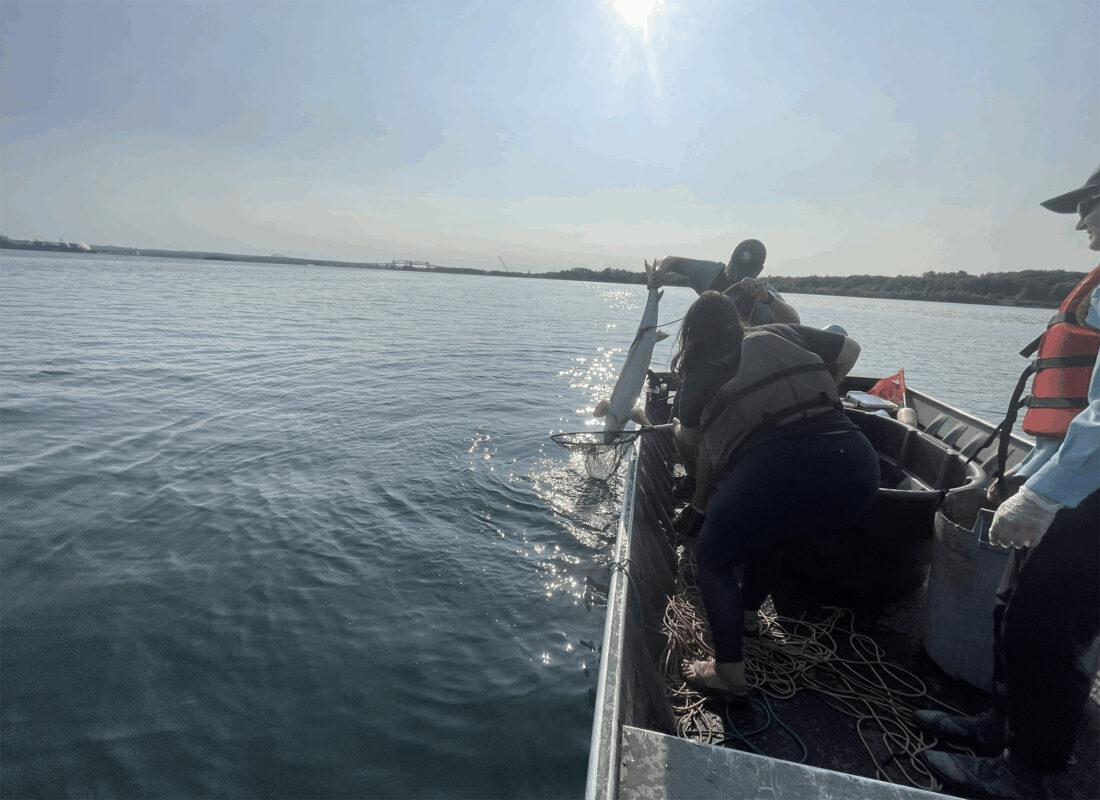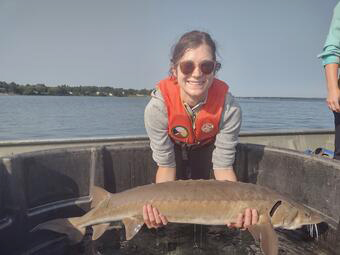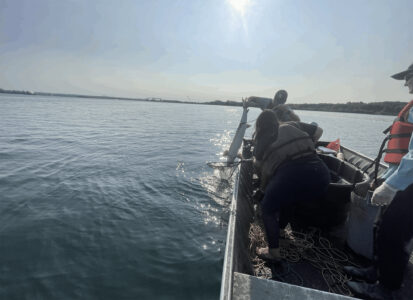Western and Indigenous knowledge will help lake sturgeon, study shows
- Researchers lift a sturgeon out of Lake Superior for sampling. (Courtesy photo)
- Holly Embke, a research fish biologist with the U.S. Geological Survey’s Midwest Climate Adaptation Science Center, holds a lake sturgeon. (Courtesy photo)

Researchers lift a sturgeon out of Lake Superior for sampling. (Courtesy photo)
LANSING – The Great Lakes have more than 100 native fish species but only one native sturgeon: the lake sturgeon.
Called “Namaew” in the Menominee language, lake sturgeon were once abundant throughout all the Great Lakes, surviving ice ages, industrialization and centuries of human pressure.
“Lake sturgeons are basically living dinosaurs, 70 million years older than the T. rex,” said Holly Embke, a research fish biologist with the U.S. Geological Survey’s Midwest Climate Adaptation Science Center.
“They can live over 100 years and grow over six feet long,” she said.
For many tribes in the Great Lakes, the return of the lake sturgeon each spring is a sign of renewal and a positive marker for the change of seasons.

Holly Embke, a research fish biologist with the U.S. Geological Survey’s Midwest Climate Adaptation Science Center, holds a lake sturgeon. (Courtesy photo)
“Sturgeon are considered knowledge holders because of their life expectancy and how long they live and a key sign of spring and of seasonal change,” Embke said.
“The Menominee tribe in Wisconsin talks about the appearance of lake sturgeon in the Wolf River as the core sign of spring and the return of their relatives to their ancestral homelands,” she said.
Sturgeon populations have severely decreased by about 80% over the last century due to overharvest during colonization, habitat loss from dam construction and their slow reproduction rate.
Climate change is hurting the sturgeon population with the warmer waters, heavier spring rains and disrupted spawning cycles.
“These fish are still trying to recover from what was done to them a hundred years ago,” said Robert Croll, a policy analyst with the Great Lakes Indian Fish and Wildlife Commission. “Climate change and loss of habitat are all making it harder for them to come back on their own.”
However, now with climate change worsening and the fish’s habitats shrinking, there are efforts to give a helping hand to the sturgeon.
A recent collaborative study, conducted through the commission, the College of Menominee Nation in Kenosha, Wis., nine tribal entities and academic researchers to understand how climate change threatens the lake sturgeon and to develop adaptation strategies rooted in tribal knowledge.
The authors included members of the Little Traverse Bay Bands of Odawa Indians in Harbor Springs and the Bay Mills Indian Community in Brimley.
“That was the first thing that we talked about as we started prepping to do the project, which was making sure that we were only going to share knowledge and data that the tribal participants authorized us to share,” said Croll, a collaborative author of the study that appeared in American Fisheries Society.
“Everyone who worked with us and all the tribal governments had an opportunity to review the paper before it was published,” Croll said.
Rather than conducting traditional field surveys, the team gathered tribal observations, cultural knowledge and community questions, adding Traditional Ecological Knowledge with scientific vulnerability assessments to lead future conservation work.
“Co-producing this research really centers on relationships. It’s about forming trust amongst tribes and partners, and coming together for a shared vision,” said Embke, another collaborative author.
Tribal communities are already helping with stocking young sturgeon, relocating adults above dams to restore spawning runs and organizing “Sturgeon Guard” programs where community members protect fish during vulnerable spawning periods.
“You’re getting the community involved in protecting these fish,” Croll said. “They’re caring for this being that, back before humans were created, agreed to help take care of us.”
Future efforts will focus on removing or modifying dams, reconnecting rivers to floodplains and restoring shorelines, nature-based solutions that benefit ecosystems, according to Embke.
“Restoring connectivity and creating the most suitable habitat possible for lake sturgeon seems to be what folks are most interested in,” Embke said.
In Michigan, the Department of Natural Resources and its partners uses streamside rearing to improve the state’s lake sturgeon population. That enables young fish to “imprint” to the river water, improving the prospects they will come back to the same river as adults.
DNR staff are assigned to streamside rearing facilities on Cheboygan County’s Black River, Menominee County’s Cedar River, Van Buren County’s Kalamazoo River and Ontonagon County’s Ontonagon River.
The Little River Band of Oddawa Indians operates a streamside rearing facility in Manistee County’s Manistee River and conduct an annual sturgeon release ceremony.
Both Embke and Croll say they see hope in the partnerships forming around the lake sturgeon. They say it’s a model for how Indigenous and Western knowledge systems can work together.
“Science can’t tell us the whole story,” Croll said. “If we’re only using science, then we’re cutting off a very important source of knowledge that could help us.”
The project showed that when science and traditional knowledge work side by side, it’s possible to create strategies to help the sturgeon recover, said Embke.
“I’ve come away from this project with so much hope,” Embke said. “The partnerships and relationships that we’ve been able to develop are really going to be able to provide some hope for lake sturgeon in the future.”
———
Isabella Figueroa Nogueira writes for Great Lakes Echo. This story originally was published by Capital News Service at Michigan State University.






